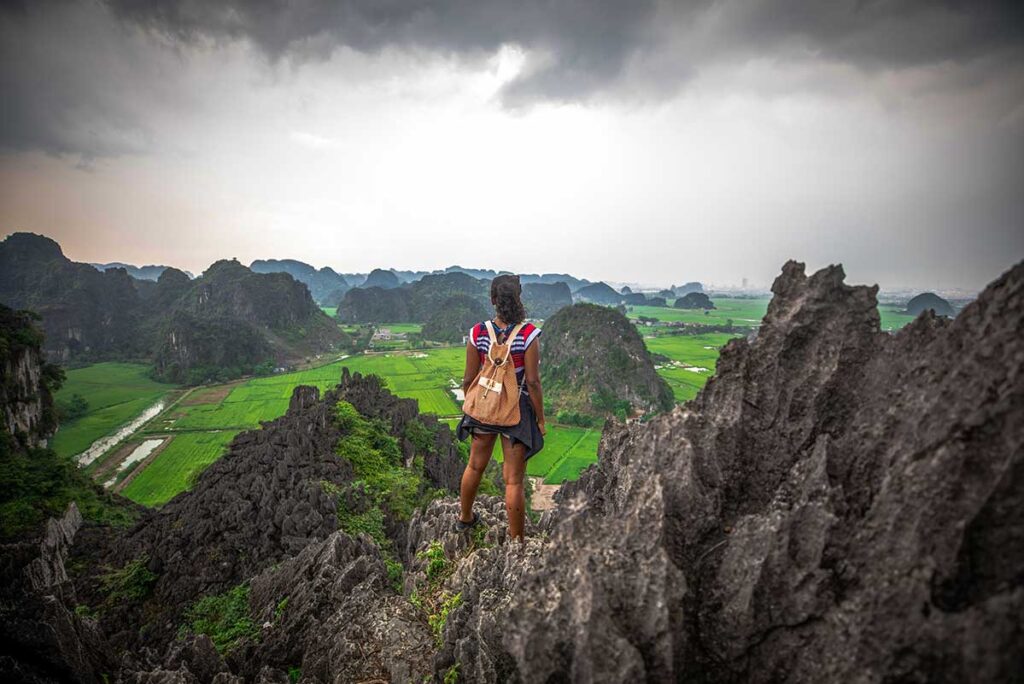What is Jesus Christ Statue Vung Tau?
Location & Setting
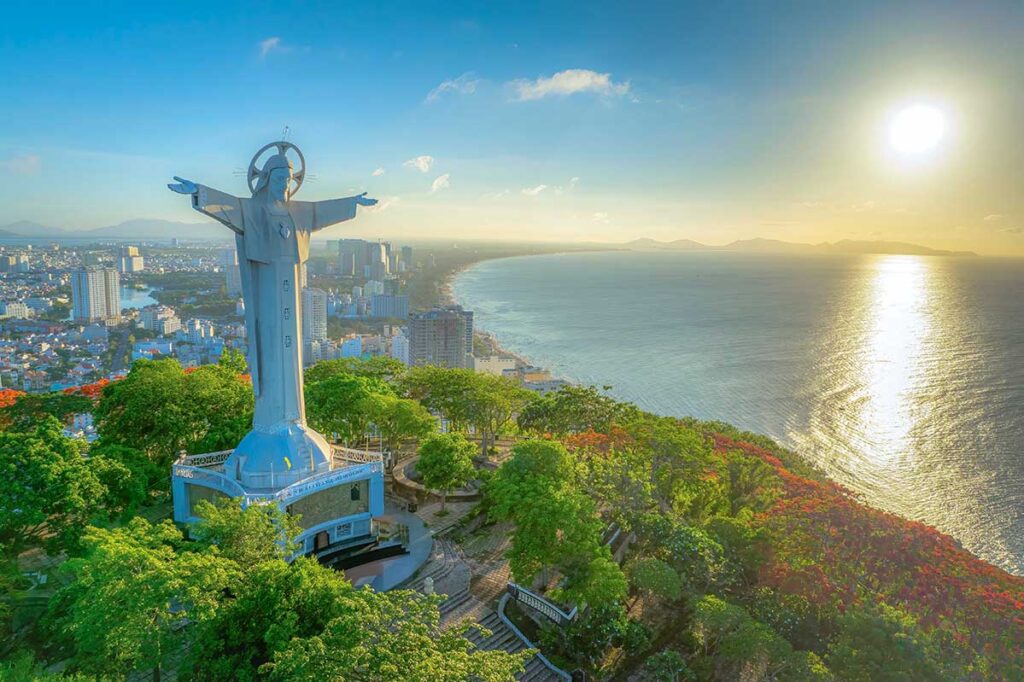
The Jesus Christ Statue Vung Tau stands on Nho Mountain (also called Small Mountain), a green hill that rises directly behind the city’s coastline. From the statue you look out over Back Beach on one side and the South China Sea on the other, making the climb as much about the views as the monument itself. The area has a mix of natural scenery and urban surroundings, so while the setting feels peaceful at the top, you’re never far from the bustle of Vung Tau below.
History
Construction of the Christ of Vung Tau began in 1972 during the time of the old Saigon government but was stopped just two years later. Work restarted in 1992 under the guidance of the Vietnamese Catholic Church, and the statue was officially completed and inaugurated on December 2, 1994. Since then, it has grown into one of Vietnam’s major pilgrimage sites and an important religious symbol for local Catholics. In 2012, it was recognized as the largest Jesus statue in Asia, and today it is also listed as a national historical and cultural relic.
Architecture & Structure
The statue itself is 32 meters tall and stands on a 4-meter platform, bringing the total height to 36 meters. With arms outstretched to a span of 18.3 meters, the figure of Christ is visible from across much of Vung Tau’s shoreline.
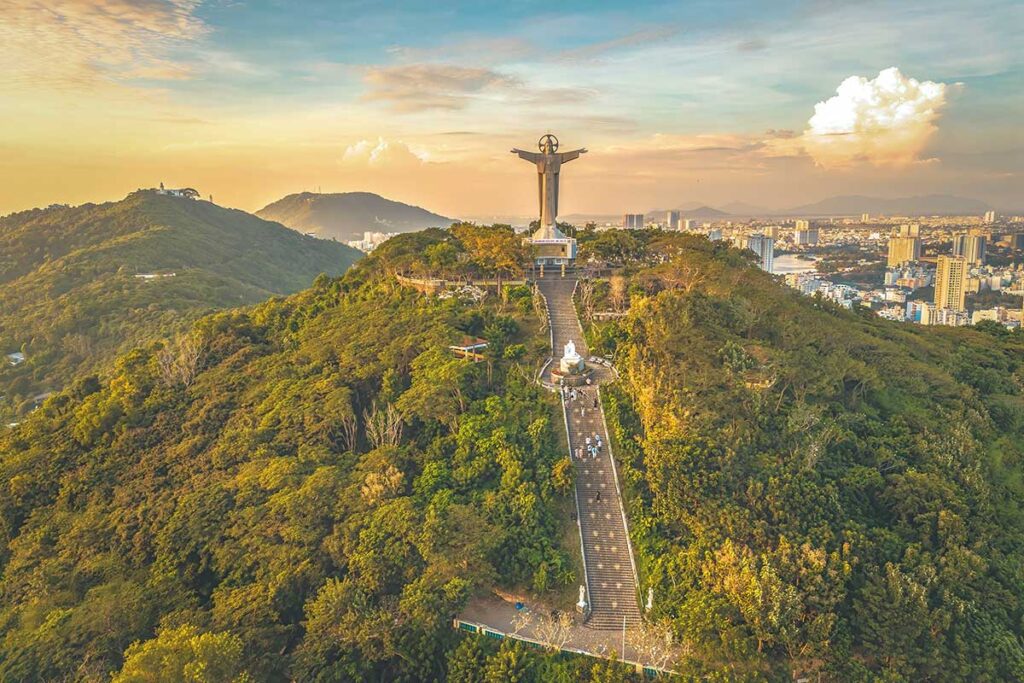

Visitors who make the climb can continue inside the statue, where a narrow spiral staircase of 133 steps leads up into the shoulders. From there, you can step out onto a small balcony inside the arms for sweeping views of the sea and city.

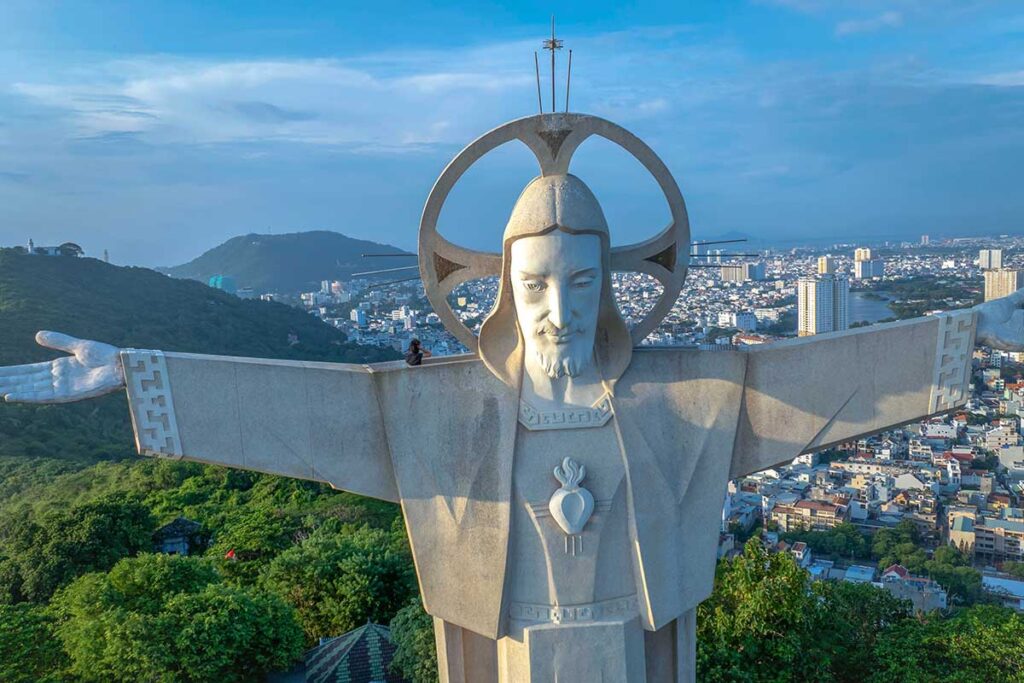
At the base, the pedestal is decorated with bas-reliefs depicting scenes such as the Last Supper and Jesus handing the keys to St. Peter. Around the site you’ll also find smaller statues, a praying area, and even a pair of century-old cannons that reflect the mountain’s past as a defensive lookout. The overall design is simple but symbolic — Christ with open arms, facing out toward the ocean, as if embracing the people of Vietnam.
Practical visiting information
Opening hours & Entrance
The Jesus Christ Statue Vung Tau is open daily from 7:00 AM to 5:00 PM, with the last entry inside the statue around 4:30 PM. There is no ticket fee, but donation boxes are placed around the site to help with upkeep.
Dress Code & Rules
Because this is a religious site, visitors are expected to dress modestly. Shorts, mini skirts, and sleeveless tops are not permitted, and you’ll need to remove your shoes before going inside the statue itself. Umbrellas are not allowed either, so a hat or cap is the better option for shade. These rules are enforced, so it’s best to come prepared to avoid being turned away.
Climb & Facilities
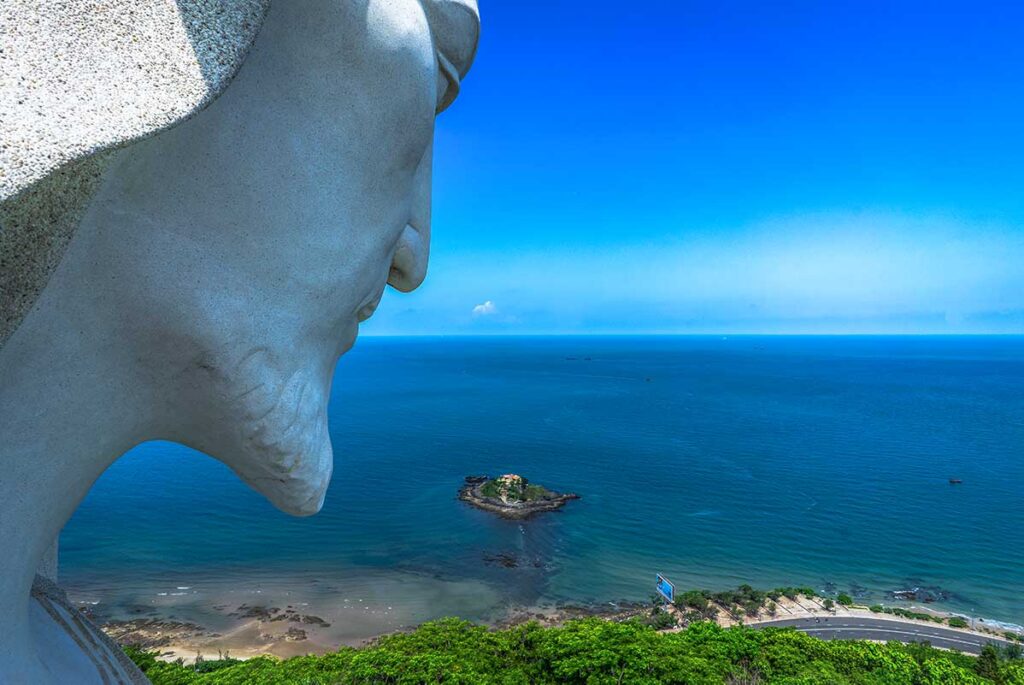
Reaching the statue requires a climb of roughly 800 steps up the mountain. Once at the base, you’ll find an additional 133 narrow spiral steps inside the statue that lead to the shoulders. The climb sounds daunting, but it is broken up with shaded rest stops, benches, and viewpoints along the way. At the bottom and midway up the path, there are small cafes, souvenir stands, and vendors selling drinks or snacks. Parking for motorbikes is available at the mountain base.
Best time to visit
The climb is fully exposed to the tropical sun, so mornings and late afternoons are the most comfortable times to go. Weekdays tend to be quieter, while weekends can get crowded with local pilgrims and tourists. Weather-wise, the dry season from November to April is more pleasant for outdoor activities, though you can visit year-round.
Nearby sites to combine
The statue is part of a scenic stretch along the coast, making it easy to combine with other sights in Vung Tau. Nearby highlights include:
- Hon Ba Island – A small island accessible by foot only at low tide.
- Vung Tau Lighthouse – One of the oldest lighthouses in Vietnam, with views of the bay.
- Nghinh Phong Cape – Popular for photos and sea views.
- White Palace – Former retreat of French governors and later Emperor Bao Dai.
- Beaches – Especially Back Beach and Vong Nguyet Beach, both nearby.
Safety & Notes
The inside staircase is steep and very narrow, so it can feel crowded, especially if you meet people coming the other way. If you’re uncomfortable with heights or tight spaces, you may prefer to admire the views from the base. Take care at the arms viewpoint — it’s safe but can feel exposed. Shops near the entrance sometimes charge inflated prices, so it’s worth bringing your own water and sun protection. A hat, sunscreen, and comfortable shoes will make the climb much easier.
How to get there
By Taxi or Grab
The most straightforward way to reach the Jesus Christ Statue Vung Tau is by taxi or Grab. From either Front Beach or Back Beach, the ride only takes around 5–10 minutes. Drivers are familiar with the site, so you won’t have trouble explaining where you want to go.
By Motorbike
Many tourists prefer renting a motorbike to get around Vung Tau, and the statue is an easy stop on a coastal ride that also passes beaches and viewpoints. Rentals are widely available and inexpensive, though technically you should have a valid license and some riding experience for insurance to apply. The road leading to the base of the mountain is simple to follow and in good condition.
By Foot (Alternative)
If you’re staying nearby, it’s also possible to reach the statue on foot. Some visitors approach from small village paths at the back of the mountain, which makes the climb feel more like a hike. While less common, it can be a pleasant alternative if you enjoy walking and want a more local route to the base of the stairs.
Is Christ of Vung Tau worth visiting?
The Christ of Vung Tau is probably the city’s most recognizable landmark besides its beaches, and it’s hard to ignore when you see it standing tall on Nho Mountain. For many visitors, the appeal is less about religion and more about the combination of panoramic views, the physical challenge of the climb, and the chance to step inside one of Asia’s largest statues of Christ. Even if you’re not religious, the experience can be rewarding.
That said, it’s not without its downsides. The strict dress code means some travelers get turned away if they’re not prepared, and the long staircase—both up the mountain and inside the statue—can be tiring in the heat. On busy days, the narrow interior staircase and small viewing balconies also mean you might have to wait your turn. Occasionally, parts of the site are closed for maintenance or construction, which can be disappointing if you don’t know in advance.
Overall, it’s worth visiting if you’re already in Vung Tau. It gives you a different perspective of the city beyond the beach, and it fits nicely into a day of exploring the coastal road along with the lighthouse, Hon Ba Island, and the White Palace. It may not be the highlight of your entire Vietnam trip, but for Vung Tau it’s an iconic stop.


